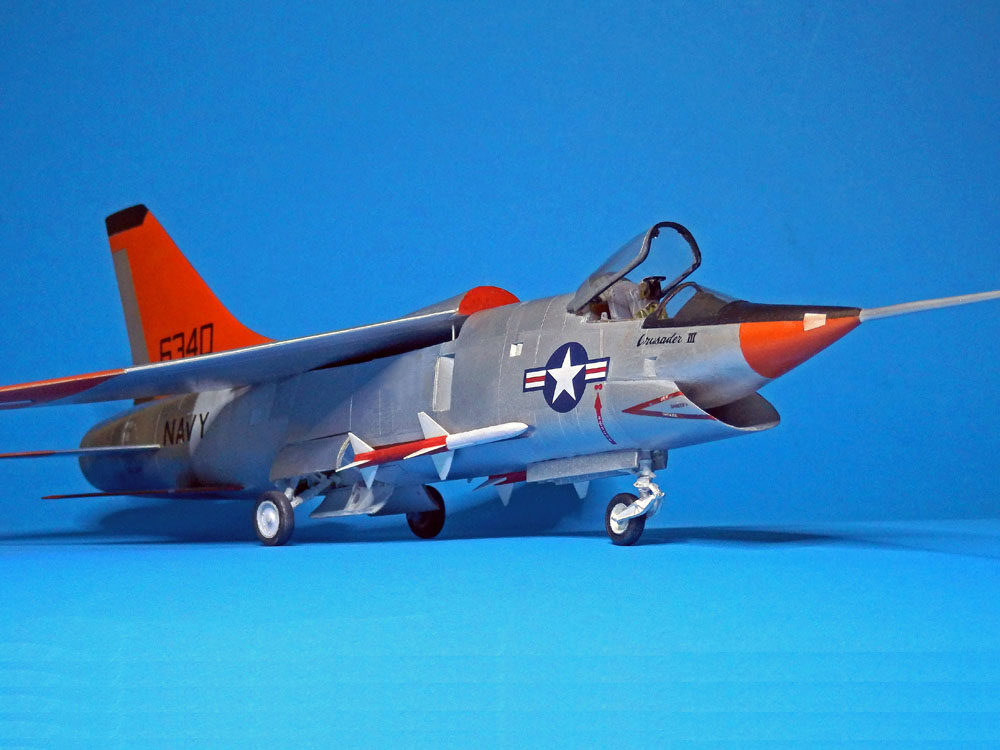|
Official comparative test flights in Nov. 1958: |
F4H-1 |
F8U-3 |
|
|
|
|
Acceleration/Min. from Mach 1,7 to 2,0 in
35.000 ft.: |
1,0 |
0,61 |
|
|
|
|
Maximum G at 2,0 Mach in 25.000 ft.: |
2,2 |
3,28 |
|
|
|
|
Height maximum at Mach 2,0 in ft.: |
52.500 |
58.100 |
|
|
|
|
Feet/Min. at Mach 2,0: |
15.000 |
31.500 |
|
|
|
|
Acceleration at Mach 2,0 (Knots per Sek.): |
1,50 |
4,98 |
|
|
|
|
Speed maximum (Mach): |
2,1 |
2,9*/2,4 |
|
|
|
|
Flight duration with internal fuel (hrs.): |
2,1 |
2,50 |
|
|
|
|
Weighth for 2,5 hours flight in lbs.: |
42.489 |
39.551 |
|
|
|
|
Armament (both Sparrow-missiles only): |
4 |
3 |
|
| |
|
*
Conceived for Mach 2.9 but not attempted
in test flights due to the then Perspex windscreen.. |
| |
|
As can be seen the Crusader III was superior to the F4H-1
Phantom II in every respect except in armament. Agility was outstanding (though
not a competition item). But there was another point: In case of
an attack the pilot would have to steer aircraft and Sparrow missile at the
same time. This may overburden an avergage pilot the BuAer reasoned. The
Phantom II did have a two place cockpit, so the second crew member could to take
care of the armament. This was the decisive difference, the test runner-up was
declared winner.
Only three Crusader III were built.
Inofficial BuAer
comment:
"The best aircraft ever we didn’t buy".
When later on a NASA-Crusader III met a Navy Phantom the NASA pilot
usually liked to show what could be done with a F8U-3: Flying circles around the
F4H-1/F4-4B. To end this embarrassing situation the Navy officially urged the
NASA to end this practice.
|
|
|
The model: |
|
|
|
Having liked this unusual looking aircraft all
the time I was more than happy to get this kit as a present from my dear friend Jürgen
S. As far as I know it's the only 1:48 one in the world and - alas - out of
production. Maybe there is still one left in the "antique" market, but
then
it'll tax your wallet.
Just to tell what you'd have to expect: Finely
engraved resin parts, white metal undercarriage, two PVC cockpit hoods
(hopefully not with a dimple on the windscreen, necessitating making a new one
in my case). Decals for the first prototype, good print, good adhesion. Due to
the small amount of parts assembly seemed easy, but soon there were some grunts
to be heard. No, this kit is no toy for sure!
The cockpit interior didn't look like the
photos I had and fixing the two pairs of stabilisers in scale thickness to the
rear was a challenge to ingenuitiy. To prevent the nose probe to part company at
the slightest touch as well I used steel wire and thinned down Evergreen tube.
Showing the model with raised wings could be done, but necessitated some extra
work in the fuselage. Well, not to forget some expertise with superglue.
But the real challenge was yet to come.
According to the current trend in painting preshading of all panel joints and
highlighting all panels with subtly different colors would be mandatory to get a
priceworthy appearance. - But a close study of photos revealed that nothing of
the said is to be seen on the real aircraft. The front part appeared as some
kind of silvery gray (painted?), the one after the wings decidedly light gray,
the after end as to be expected, streaky steel. Well, this makes things
easier I thought, but not after having bought Valejo paints. Obviously stored
too long in the store they could be used only for a short time. So painting was
a chore. Luckily Testors Aluminum helped (having waited about 30 years to be
discovered). International Orange also Testors, the rest Revell. In the outcome the
model is less spectacular - you may call it boring - but that's what I wanted to
have. A miniature replica of the original F8U-3.
|
|
|
|
|
|
